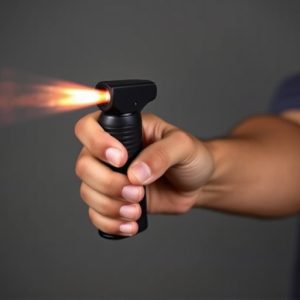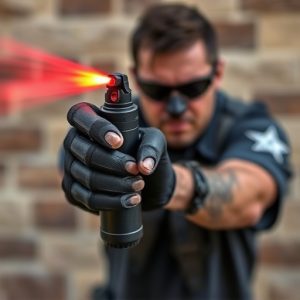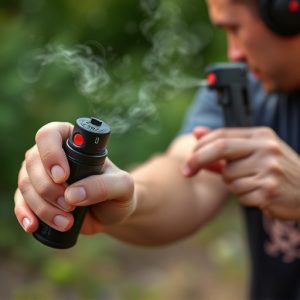Non-Lethal Defense: Understanding Pepper Spray’s Effectiveness and Duration
Pepper spray, a popular non-lethal self-defense tool, temporarily disables aggressors through its ac…….
Pepper spray, a popular non-lethal self-defense tool, temporarily disables aggressors through its active ingredient capsaicin, causing breathing difficulty, teary eyes, and severe burning sensations. The effects typically last 20 to 60 minutes, depending on concentration and environmental conditions like humidity. While effective for personal safety, proper training, understanding legalities, and responsible ownership are crucial, as these factors impact both the tool's effectiveness and its potential to cause harm.
“Discover the power of non-lethal inflammatory self-defense tools, offering a revolutionary approach to personal safety. This comprehensive guide explores an essential option in pepper spray, its scientific impact, and how long its effects endure. From understanding the mechanism behind its potency to navigating safe use practices, this article equips readers with knowledge. Learn about the duration of pepper spray’s effects and crucial considerations for effective self-defense, ensuring you’re prepared and informed.”
- Understanding Non-Lethal Inflammatory Self-Defense Tools
- The Science Behind Pepper Spray: How It Works and Its Effects
- Duration of Pepper Spray: What You Need to Know
- Considerations for Safe and Effective Use of Non-Lethal Self-Defense
Understanding Non-Lethal Inflammatory Self-Defense Tools
Non-lethal inflammatory self-defense tools, such as pepper spray, have gained significant attention for their ability to deter and disable aggressors without causing permanent harm. These tools are designed to induce temporary disorientation and pain, allowing users to escape dangerous situations. Pepper spray, in particular, is a popular choice due to its effectiveness against both humans and animals.
The effect of pepper spray lasts for a period varying from 20 minutes to an hour, depending on the concentration and application method. During this time, the user experiences difficulty breathing, teary eyes, and a strong burning sensation in the nose and throat. This temporary incapacitation provides enough time for individuals to seek safety or call for help, making pepper spray a valuable tool for personal protection.
The Science Behind Pepper Spray: How It Works and Its Effects
Pepper spray, a non-lethal inflammatory self-defense tool, creates its effect through the introduction of capsaicin, the active ingredient found in chili peppers. When sprayed onto the skin or eyes, capsaicin binds to specific nerve endings, triggering a sensation of intense pain and irritation. This reaction causes the body’s natural response to include constriction of airways and dilated blood vessels, leading to temporary blindness, difficulty breathing, and severe discomfort. The effects typically last anywhere from 20 minutes to an hour, depending on the concentration of capsaicin and the individual’s sensitivity.
The duration of pepper spray’s effects plays a crucial role in its effectiveness as a self-defense mechanism. While it provides enough time for an individual to escape or seek help, the temporary nature of the symptoms also ensures that there is no lasting harm. This balance between deterrence and safety makes pepper spray a popular choice for personal protection, particularly in situations where non-lethal force is preferred.
Duration of Pepper Spray: What You Need to Know
Pepper spray, a popular non-lethal self-defense tool, creates a temporary but intense disorientation for the target. The duration of its effects can vary greatly, primarily depending on factors such as the concentration of capsaicin (the active ingredient), weather conditions, and individual sensitivity. Typically, pepper spray will cause symptoms like tearing, burning eyes, coughing, and difficulty breathing for several minutes, often ranging from 20 to 60 minutes.
However, it’s crucial to remember that the intensity and longevity of pepper spray’s effects can differ significantly. Higher concentrations typically offer longer-lasting protection, while lower concentrations may wear off quicker. Environmental conditions like high humidity can also reduce the spray’s effectiveness over time. Understanding these variables is essential for users to make informed decisions regarding their safety and the level of protection they require.
Considerations for Safe and Effective Use of Non-Lethal Self-Defense
When considering non-lethal inflammatory self-defense tools like pepper spray, safety and effectiveness are paramount. It’s crucial to understand that while these tools provide a temporary deterrent, they should be used as a last resort. Training is essential; users must know how to deploy the spray accurately and safely, ensuring it doesn’t pose harm to themselves or bystanders. The range and duration of effects vary with pepper spray types, but typically, they can incapacitate an assailant for several minutes, providing enough time to escape and seek help.
Another vital consideration is environmental factors; wind direction and weather can significantly impact the spray’s reach and effectiveness. Users should also be aware of legal implications and local regulations surrounding pepper spray ownership and use. Responsible ownership includes proper storage and securing the device to prevent unauthorized access. Additionally, regular maintenance and checking expiration dates are essential for ensuring the spray remains potent and functional when needed.
Non-lethal inflammatory self-defense tools, like pepper spray, offer a crucial option for personal safety. Understanding their science and proper usage is essential. Knowing how long pepper spray effects last (typically ranging from 20 minutes to an hour) can significantly impact their effectiveness during dangerous situations. Always consider safety precautions and responsible use to ensure these tools serve as effective deterrents without causing prolonged harm.


